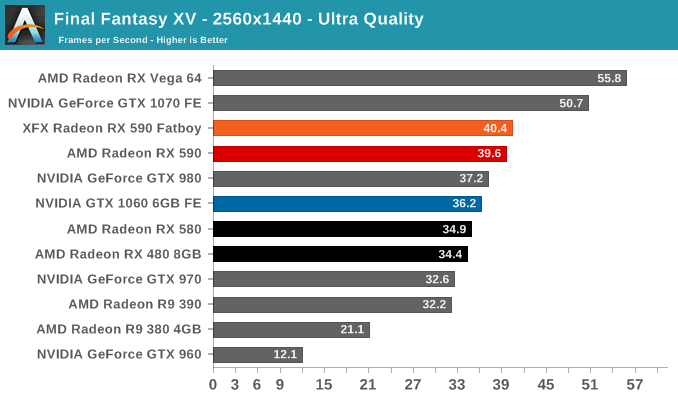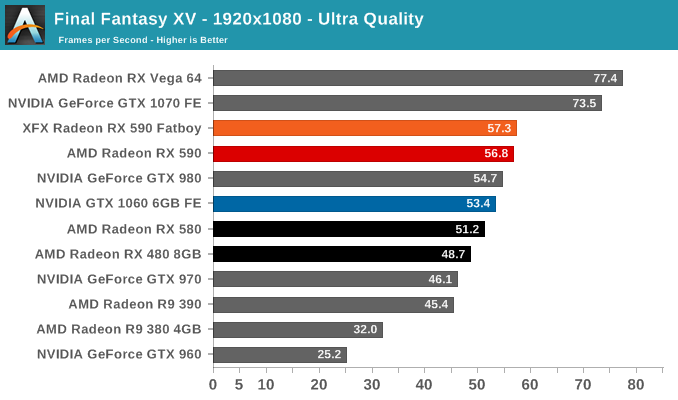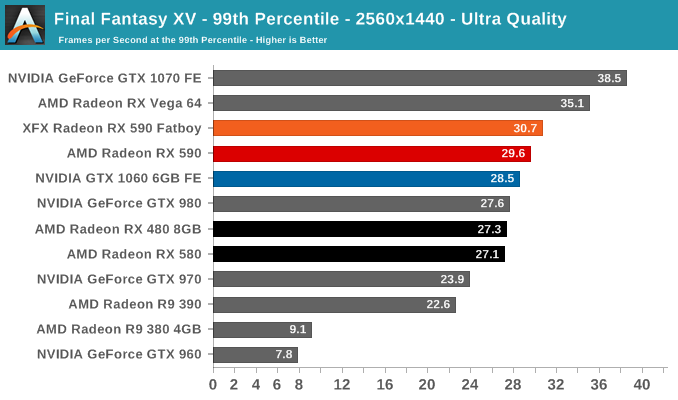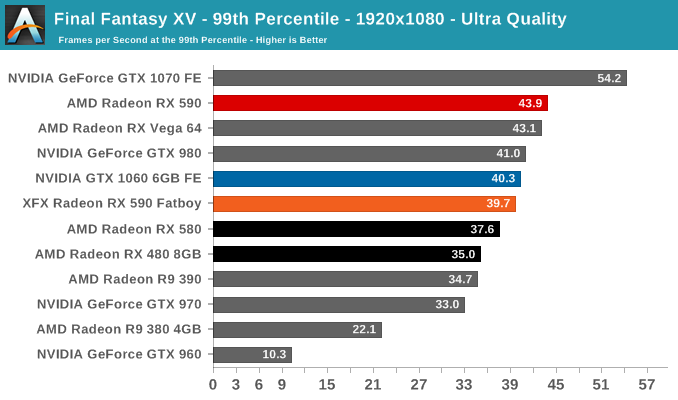The AMD Radeon RX 590 Review, feat. XFX & PowerColor: Polaris Returns (Again)
by Nate Oh on November 15, 2018 9:00 AM ESTFinal Fantasy XV (DX11)
Upon arriving to PC earlier this, Final Fantasy XV: Windows Edition was given a graphical overhaul as it was ported over from console, fruits of their successful partnership with NVIDIA, with hardly any hint of the troubles during Final Fantasy XV's original production and development.
In preparation for the launch, Square Enix opted to release a standalone benchmark that they have since updated. Using the Final Fantasy XV standalone benchmark gives us a lengthy standardized sequence to utilize OCAT. Upon release, the standalone benchmark received criticism for performance issues and general bugginess, as well as confusing graphical presets and performance measurement by 'score'. In its original iteration, the graphical settings could not be adjusted, leaving the user to the presets that were tied to resolution and hidden settings such as GameWorks features.
Since then, Square Enix has patched the benchmark with custom graphics settings and bugfixes to be much more accurate in profiling in-game performance and graphical options, though leaving the 'score' measurement. For our testing, we enable or adjust settings to the highest except for NVIDIA-specific features and 'Model LOD', the latter of which is left at standard. Final Fantasy XV also supports HDR, and it will support DLSS at some later date.


For Final Fantasy XV, the older R9 380 and GTX 960 simply can't keep up with the demands and are essentially unplayable with particularly low 99th percentiles. VRAM wouldn't be the sole issue - though FFXV does use high resolution textures - as the GTX 980 (4GB) performs up to par. NVIDIA hardware tends to perform well on FFXV but as with Ashes: Escalation, the RX 590's extra performance permits it to claim victory, reference-to-reference, which the RX 580 was unable to do here.













136 Comments
View All Comments
Opencg - Thursday, November 15, 2018 - link
Its just a gap filler. It will help them make money from people wanting to get good performance at that price but... we're still waiting for the serious contenders. Vega refresh will be a little more toward the high end but... navi is where amd could potentially shift the market. RTX means you pay more for less performance outside rtx games. Navi is the opposite you pay less and get more. We need navi to function well and I believe amd can do it.neblogai - Thursday, November 15, 2018 - link
Is is not a gap filler. It is only there, because overproduction of P20 needs to be sold out first. Naturally- P30 should be a replacement of P20, at same price, with minimal investment by MAD or partners.eva02langley - Thursday, November 15, 2018 - link
Polaris is selling well, Vega, not so much beside mining. In Canada, the price are still having a huge price tag because the supply is just so low.Allan_Hundeboll - Thursday, November 15, 2018 - link
I am surprised a boost frequency increase of 15% nets 12% overall performance. Maybe Polaris isn't as starved for memory bandwidth, as people seem to think. Or AMD made other improvements besides the increased frequency...?mapesdhs - Thursday, November 15, 2018 - link
Frequency increases rarely produce linear performance gains, not when there are so many other aspects of a system that impact what's happening (main CPU, API, game engine, etc.)Allan_Hundeboll - Thursday, November 15, 2018 - link
Yes that is why I'm surprised 15% increase on the core frequency -without any increase of the Vram frequency, would result in 12% overall performance increase. Especially considering the "original Polaris" rx480 was configured with 1266Mhz core boost frequency and 2000Mhz Vram.If AMD figured 1266/2000MHz was near the sweet spot balance between core/mem speed then 1545/2000 would be severly starved for memory bandwidth.
So I'm wondering if 2000MHz memory speed was kind of wasted on the rx480? Or did AMD tighten the Vram timings on this new 590? Or maybe the near linear increase in performance is due to the higher tdp allowing the rx590 to sustain the boost clock while the 480 would throttle to base core frequency of 1120MHz?
SlowSpyder - Thursday, November 15, 2018 - link
Where is 7nm Vega??mapesdhs - Thursday, November 15, 2018 - link
Never going to happen, because gamers won't buy it.https://www.youtube.com/watch?v=guK2XoFbPFw
https://www.youtube.com/watch?v=USMlET3L7mA
Cyborg997 - Thursday, November 15, 2018 - link
Summer 2019 or late 2019. Definitely soon rtx fighter.schujj07 - Thursday, November 15, 2018 - link
The most surprising thing to me is just how good RX480 is when you look at the benchmarks. When it launched it was as fast as the GTX970, now it is faster than then GTX980 just due to drivers and newer games being able to use its resources better.